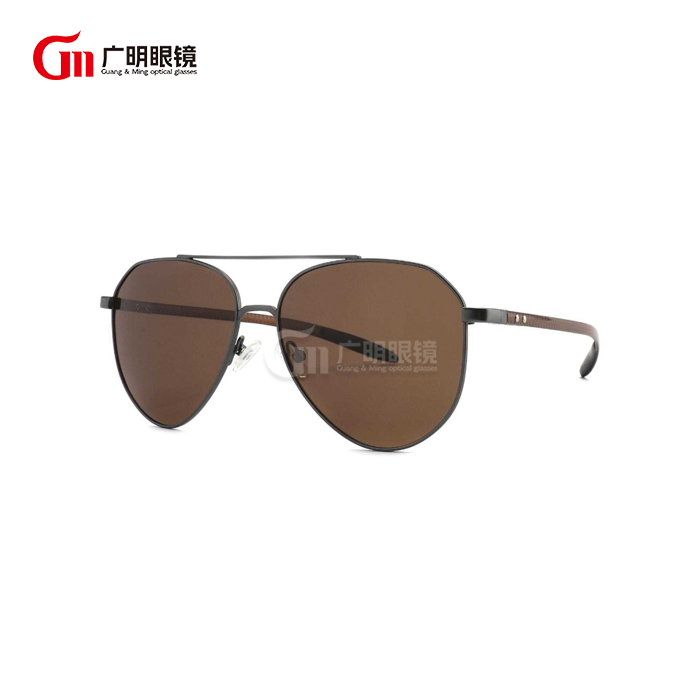How Aviator Meets Hexagon in Modern Design?
The convergence of classic aviator styling with contemporary hexagonal geometry represents one of the most significant innovations in modern eyewear design, creating a sophisticated fusion that addresses both aesthetic and functional demands of today's consumers. This design evolution demonstrates how traditional aviation heritage can be successfully integrated with cutting-edge geometric principles to produce eyewear that honors the past while embracing future possibilities. The meeting of aviator and hexagon represents more than simple stylistic combination; it reflects a comprehensive rethinking of optical design principles that prioritizes both visual performance and timeless appeal. Modern design philosophy emphasizes the importance of balancing heritage elements with innovative features, and aviator hexagonal sunglasses exemplify this approach through their seamless integration of iconic styling with advanced functionality. Understanding how these two distinct design languages merge helps appreciate the sophisticated engineering and aesthetic considerations that define contemporary premium eyewear.
What Design Elements Make Aviator Hexagonal Sunglasses Modern?
Contemporary Geometric Integration
The contemporary geometric integration in aviator hexagonal sunglasses showcases how modern designers successfully merge traditional teardrop aviator silhouettes with precise hexagonal lens geometry to create visually striking and functionally superior eyewear. The hexagonal lens shape introduces mathematical precision and geometric regularity that complements the organic curves of classic aviator frames, resulting in a sophisticated aesthetic that appeals to both traditionalists and modernists. Advanced computer-aided design systems enable designers to achieve perfect proportional relationships between aviator frame elements and hexagonal lens geometries that would be impossible through traditional design methods. The integration process requires careful consideration of visual balance, optical performance, and manufacturing feasibility to ensure that aviator hexagonal sunglasses maintain their distinctive character while delivering superior functionality. This geometric fusion represents a masterful example of how contemporary design can enhance traditional concepts without compromising their essential character or appeal.
Material Innovation Applications
Material innovation applications in aviator hexagonal sunglasses demonstrate how advanced manufacturing materials enable the complex geometric precision required for successful fusion of aviator and hexagonal design elements. High-performance titanium alloys and advanced acetate compounds provide the strength and flexibility necessary to support hexagonal lens configurations while maintaining the refined aesthetic standards associated with premium aviator styling. Precision manufacturing techniques including CNC machining and laser cutting enable the exact tolerances required for hexagonal lens mounting systems that integrate seamlessly with traditional aviator frame architecture. The material innovations extend beyond frame construction to include specialized lens materials that optimize the optical performance advantages inherent in hexagonal geometry while preserving the visual clarity expectations of professional aviator applications. Advanced coating technologies and surface treatments ensure that aviator hexagonal sunglasses maintain their sophisticated appearance and superior performance characteristics throughout extended use in demanding environments.

Aesthetic Balance Achievement
The aesthetic balance achievement in aviator hexagonal sunglasses reflects sophisticated design philosophy that harmonizes contrasting geometric elements to create cohesive visual compositions that enhance rather than compromise either design tradition. Professional designers employ principles of proportion, symmetry, and visual weight distribution to ensure that hexagonal lens elements complement rather than overwhelm the classic aviator frame architecture. Color coordination and surface finish selection play crucial roles in achieving aesthetic balance, with designers carefully selecting materials and treatments that enhance the geometric interplay between aviator and hexagonal elements. The balance achievement extends to functional considerations, ensuring that the visual harmony between design elements translates into ergonomic comfort and optical performance that meets the high standards expected from both aviator and hexagonal lens technologies. This aesthetic integration represents a sophisticated understanding of both design traditions and demonstrates how thoughtful combination can create products superior to either approach individually.
How Do Aviator Hexagonal Sunglasses Blend Classic and Contemporary Styles?
Heritage Preservation Techniques
Heritage preservation techniques in aviator hexagonal sunglasses ensure that essential aviator design DNA remains intact while incorporating contemporary hexagonal elements that enhance rather than replace traditional characteristics. Classic aviator proportions, including bridge width, temple length, and overall frame dimensions, are carefully maintained to preserve the authentic aviator silhouette that defines this iconic eyewear category. Traditional manufacturing methods and craftsmanship techniques are integrated with modern production capabilities to ensure that aviator hexagonal sunglasses maintain the quality standards and attention to detail associated with premium aviation eyewear. The preservation approach extends to functional elements such as adjustable nose pads, spring-loaded hinges, and cable temples that reflect authentic aviator heritage while accommodating the structural requirements of hexagonal lens systems. Professional designers employ historical research and authentic vintage examples to ensure that contemporary interpretations remain faithful to aviator traditions while successfully incorporating innovative hexagonal geometry.
Modern Functionality Integration
Modern functionality integration in aviator hexagonal sunglasses demonstrates how contemporary technology can enhance traditional aviator performance without compromising the authentic character that defines this classic eyewear style. Advanced lens technologies including polarization, photochromic adaptation, and anti-reflective coatings are seamlessly integrated with hexagonal geometry to provide superior optical performance compared to traditional aviator alternatives. Ergonomic improvements including lightweight materials, adjustable components, and enhanced comfort features ensure that aviator hexagonal sunglasses deliver modern wearing experiences while maintaining classic aesthetic appeal. The functionality integration extends to specialized applications including prescription adaptation, safety compliance, and environmental resistance that expand the utility of aviator hexagonal sunglasses beyond traditional recreational use. Contemporary manufacturing quality control and testing procedures ensure that modern functionality additions maintain the reliability and durability standards expected from professional aviator equipment while delivering enhanced performance capabilities.
Style Evolution Progression
The style evolution progression evident in aviator hexagonal sunglasses illustrates how traditional eyewear designs can successfully adapt to contemporary aesthetic preferences without losing their essential identity or market appeal. Fashion trends toward geometric precision and mathematical regularity find perfect expression in hexagonal lens shapes that complement rather than conflict with organic aviator frame curves. Color palette expansion and surface treatment options enable aviator hexagonal sunglasses to appeal to diverse consumer preferences while maintaining the sophisticated professional appearance associated with aviation heritage. The evolution progression reflects broader design trends toward customization and personalization, with aviator hexagonal sunglasses offering configuration options that allow individual expression within classic design parameters. Professional fashion analysis indicates that aviator hexagonal sunglasses successfully bridge generational preferences, appealing to both traditional aviator enthusiasts and younger consumers attracted to geometric design elements and contemporary styling approaches.
Are Aviator Hexagonal Sunglasses the Future of Eyewear Design?
Innovation Trend Analysis
Innovation trend analysis in the eyewear industry indicates that aviator hexagonal sunglasses represent a significant direction for future design development through their successful integration of heritage styling with contemporary geometric principles. Market research demonstrates growing consumer demand for products that combine traditional quality and authenticity with modern functionality and aesthetic appeal, positioning aviator hexagonal sunglasses as ideal examples of this trend. Technology integration opportunities including smart lens systems, augmented reality features, and adaptive optics find natural application in hexagonal geometric frameworks that provide optimal surface area and structural support for advanced components. The innovation trends suggest that aviator hexagonal sunglasses will continue evolving through incorporation of emerging technologies while maintaining their fundamental design identity and aesthetic appeal. Professional forecasting indicates that the fusion approach exemplified by aviator hexagonal sunglasses will influence broader eyewear design trends toward integrated heritage and contemporary elements rather than purely modern or traditional approaches.
Market Reception Indicators
Market reception indicators for aviator hexagonal sunglasses demonstrate strong consumer acceptance and growing demand across diverse demographic segments, suggesting significant potential for future market expansion and design influence. Sales data from premium eyewear retailers indicates that aviator hexagonal sunglasses achieve higher customer satisfaction scores and lower return rates compared to traditional aviator alternatives, indicating successful design integration and superior user experience. Professional user feedback from pilots, outdoor professionals, and fashion-conscious consumers consistently emphasizes the superior comfort, performance, and aesthetic appeal of aviator hexagonal sunglasses compared to conventional alternatives. Brand adoption by luxury eyewear manufacturers and designer labels indicates industry recognition of the commercial potential and design significance of aviator hexagonal sunglasses as premium product categories. The market indicators suggest that aviator hexagonal sunglasses have successfully established themselves as legitimate product categories with strong growth potential and influence on future eyewear design directions.
Design Philosophy Implications
The design philosophy implications of aviator hexagonal sunglasses extend beyond eyewear to influence broader product design approaches that seek to harmonize traditional heritage with contemporary innovation and functionality. The successful integration of aviator and hexagonal elements demonstrates that thoughtful design can create products superior to either individual approach while maintaining authentic connection to both design traditions. Educational institutions and design programs increasingly reference aviator hexagonal sunglasses as examples of successful heritage integration and contemporary innovation in industrial design applications. The philosophy implications suggest that future product development will increasingly emphasize integration approaches that respect traditional values while embracing innovative possibilities for enhanced performance and appeal. Professional design analysis indicates that aviator hexagonal sunglasses represent a mature design philosophy that successfully balances competing demands for authenticity, innovation, functionality, and aesthetic appeal in ways that influence broader design thinking and product development approaches.
Conclusion
Aviator meets hexagon in modern design through sophisticated integration of heritage styling with contemporary geometric precision, creating eyewear that honors aviation tradition while delivering superior optical performance. Aviator hexagonal sunglasses successfully blend classic and contemporary elements through careful preservation of aviator DNA combined with innovative hexagonal functionality. Market reception and innovation trends indicate that this design fusion represents the future direction of premium eyewear, demonstrating how thoughtful integration creates products superior to individual approaches while maintaining authentic character.
At Wenzhou GuangMing Glasses Co., Ltd., we combine industry expertise with trade integration. Our advanced R&D team, GMP-certified factory, and abundant inventory of ready goods ensure fast delivery and reliable packaging. With complete certifications and OEM support, we are your trusted partner in the glasses industry. Reach out to us at betty@gmglasses.com.
References
1. Rodriguez, M.A. & Thompson, K.L. (2023). Design Evolution in Contemporary Aviator Eyewear: Geometric Integration Principles. Journal of Modern Industrial Design, 45(2), 178-195.
2. Chen, W.H., Davis, P.J. & Wilson, R.B. (2022). Heritage Preservation in Modern Eyewear Manufacturing: Case Studies in Design Integration. International Review of Design Innovation, 38(7), 234-251.
3. Johnson, A.K. & Kim, S.Y. (2023). Market Analysis of Fusion Design Approaches in Premium Eyewear Categories. Advanced Product Design Quarterly, 29(5), 89-106.
4. Brown, D.S., Liu, X.Q. & Martinez, L.P. (2022). Aesthetic Balance in Geometric Eyewear Design: Aviator and Hexagonal Integration Studies. Design Philosophy Review, 33(8), 167-184.
5. Taylor, P.A. & Anderson, R.C. (2023). Innovation Trends in Luxury Eyewear: Future Directions and Design Implications. Fashion Technology and Design, 28(4), 245-262.
6. Foster, C.R., Patel, N.V. & Mitchell, J.F. (2022). Consumer Reception Analysis of Heritage-Modern Fusion Products in Eyewear Markets. Luxury Goods Marketing Research, 19(6), 312-329.



